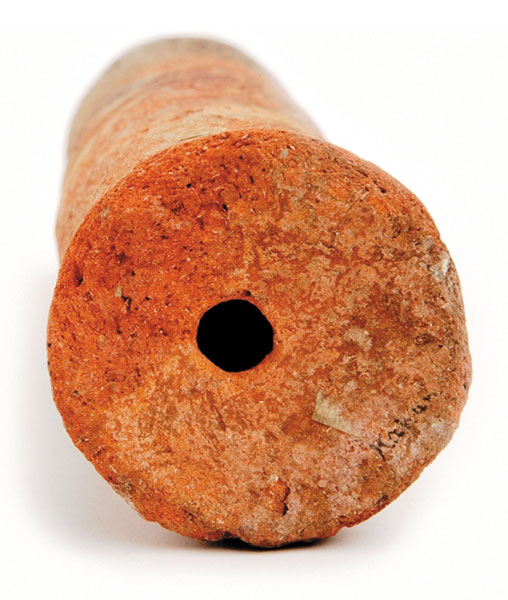
A. Israelite rolling pin
B. Hittite rain stick
C. Irrigation pipe from Mesopotamia
D. Egyptian beehive
E. Mycenaean grape press
Answer: (D) Egyptian beehive
This 15-inch-long clay cylinder, recovered from the ancient Egyptian town of Kahun southwest of Saqqara, is a handcrafted beehive that was used to harvest valuable honey and wax during the Egyptian Middle Kingdom (c. 2055–1650 B.C.E.). One end of the narrow, 3-inch-wide cylinder (shown) features a small hole that allowed bees to fly in and out of the hive, while the opposite end is now open but was presumably covered with a removable lid or clay stopper that gave beekeepers access to the vessel’s interior. At harvest time, the lid was opened and beekeepers would blow smoke into the hive, flushing the bees out, allowing the honey and wax to be removed. Had it not been for the remains of an ancient bee found inside, however, researchers may never have realized the object’s function.1
Ancient Egyptian tomb paintings as well as traditional beekeeping techniques indicate that these cylindrical hives were typically stacked horizontally, sometimes by the hundreds, in order to harvest honey and beeswax on an industrial scale. A similar and remarkably well preserved beekeeping installation (or apiary) dating to the ninth century B.C.E. was recently identified at Tel Rehov in the Jordan Valley.a The hives, which may have numbered as many as 200 and housed more than 2 million bees, produced as much as half a ton of honey per year.
MLA Citation
Footnotes
Trude Dothan, “Philistine Fashion: Ear Plugs from Ekron,” BAR 29:06.
Endnotes
Lawrence E. Stager, “Chariot Fittings from Philistine Ashkelon,” in Seymour Gitin, J. Edward Wright and J.P. Dessel, eds, Confronting the Past: Archaeological and Historical Essays on Ancient Israel in Honor of William G. Dever (Winona Lake, IN:Eisenbrauns, 2006), pp. 169–176. See also Trude Dothan and Alexandra S. Drenka, “Linchpins Revisited,” in J. David Schloen, ed., Exploring the Longue Durée: Essays in Honor of Lawrence E. Stager (Winona Lake, IN: Eisenbrauns, 2009), pp. 97–101.

